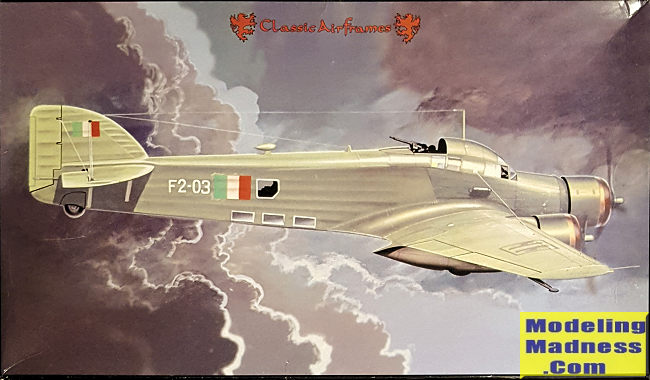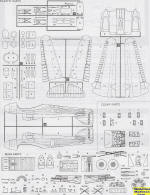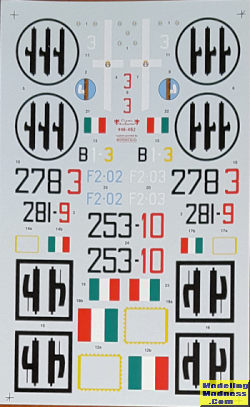
Classic Airframes 1/48 SM.79 Sparviero
| KIT #: | 462 |
| PRICE: | $64.95 SRP when new |
| DECALS: | Six options |
| REVIEWER: | Scott Van Aken |
| NOTES: | Short run kit with resin and photo etch parts |

| HISTORY |
After the Armistice, the Repubblica Sociale Italiana (RSI) decided to continue using the SM.79s as torpedo-bombers. But only 15 more Sparvieri were built after the armistice, while five were overhauled by the Reggiane factories. Counting the aircraft taken over from the Regia Aeronautica, new deliveries and aircraft in workshops and depots, the Aeronautica Nazionale Repubblicana (ANR) had 73 SM.79 at its disposal. They were mostly SM.79-III type. This version featured strengthened armament and had no ventral "bathtub" turret. They were based mostly in Venegono. Two secondary bases were Merna di Gorizia and Perugia, in Umbria.
The first missions attempted to oppose the Anzio landings, where the British and American forces had landed on 22 January 1944. On the evening of 10 March, a flight of six ANR SM.79s attacked Allied merchant ships near the Anzio-Nettuno beachhead, during which a single Sparviero was lost. On the night of 13–14 March five SM.79s repeated the attack.
The Gruppo Buscaglia suffered heavy losses on 4 April, when 13 unescorted SM.79s, during a ferry flight from Lonate Pozzolo to Perugia, were bounced by P-47s: five Sparvieri were shot down and 27 crew members were killed. According to other sources, this encounter occurred on 6 April and four out of seven SM.79s were shot down, while the other three crash-landed. During one of the missions on Anzio, Comandante Carlo Faggioni was killed. On 10 April 1944, four SM.79s took off to attack the Anzio bridgehead. Capitano Faggioni's aircraft was hit by AA fire and crashed into the sea; only one Sparviero was able to return to base. Immediately thereafter, Capitano Marino Marini took command of the torpedo-bomber group; early on, Marini set about planning a mission over Gibraltar.
For this mission, 12 SM.79 bis models were used. They had enhanced engines, armoured shields for the lateral machine guns, an additional 1,000 L (264 US gal) fuel tank in the bomb bay, and had the bombardier's nacelle removed. Even these modifications could not provide sufficient range to achieve the necessary distance that the mission required, and so all weapons except one were removed, one member of crew was left behind, and the fuel load was increased to 5,000 L (1,320 US gal). To reach Gibraltar, it was necessary to take off from Istres, in Southern France, and then fly for a total of 2,700 km (1,700 mi). Of the 12 aircraft that departed from Istres on 5 June 1944, 10 reached their target (according to other sources, ten SM.79s took off on 4 June and nine reached the target). The defenders were taken by surprise, and all the aircraft successfully launched their torpedoes, but three SM.79s ran out of fuel and were forced to land in Spain. Initial claims by the Italians were four ships sunk, totalling 27,216 tonnes (30,000 tons). German observers in Algeciras, in Spain, reported that four ships, totalling 30,000 tons were badly damaged and that two others had been hit. British sources however stated that no ships were lost, due to an effective system of defence. Regardless, this was the largest enemy incursion over Gibraltar in four years of war and this operation demonstrated the flying skill of the Republican torpedo airmen.
During July 1944, several SM.79s were transferred to Eleusis/Athens base to carry out sorties in the Eastern Mediterranean. Their crews achieved some successes then and came back to Lonate Pozzolo on 12 August. In October, this formation was renamed Gruppo O.M. Carlo Faggioni. After a time, the RSI torpedo-bombers based in Ghedi in October 1944 became operative again, with 10 aircraft. On 25 December 1944 they attacked a convoy in Adriatic sea off Ancona, and Capitano Bertuzzi hit a 7,000-ton freighter with a torpedo. The following day, a formation of Republic P-47 Thunderbolt destroyed 14 "Sparvieri" on Lonate Pozzolo airfield. The only two serviceable SM.79s left flew the last operational mission of the group and sank a 5,000-ton ship in the Adriatic off the Dalmatian coast.
| THE KIT |
 Back
before Classic Airframes went out of business, they offered a fairly wide
variety of interesting kits. Each of their kits was very much a short run kit
with resin and photo etch used for the detail. It has been widely suggested that
C.A. kits were designed and tooled by MPM's 'second team' as the kits were often
quite difficult to build. As such, one needs to have experience with these sorts
of kits before starting out.
Back
before Classic Airframes went out of business, they offered a fairly wide
variety of interesting kits. Each of their kits was very much a short run kit
with resin and photo etch used for the detail. It has been widely suggested that
C.A. kits were designed and tooled by MPM's 'second team' as the kits were often
quite difficult to build. As such, one needs to have experience with these sorts
of kits before starting out.
The kit itself provides a lot of detail. Plastic is used for the base airframe with all of the interior being resin with photo etch details. The kit does offer several options and the first to consider is whether you want to dorsal gun position exposed or not. If so, break out the saw as you'll need to remove the cover of the opening. Note also that you have to make a lot of small bits out of wire (like the gun pedastal and gear door hinges) so be prepared for that. Note also that the tail gear assembly is resin and has to be installed prior to assembling the fuselage halves so it would be wise to make a cover for it to protect it. All the fuselage windows install from the inside prior to closing the fuselage halves.
When installing the tailplanes, keep in mind that the
upper portions were wire braced. The wings are five pieces. One lower center
section with outer upper and lower halves. All of the actuating controls and
balances are resin and it would be wise to leave these off until later. It has
been suggested that the center section be attached to the fuselage first and
then the outer wings can be adjusted to fit. Building the wings in whole then
attaching them will cause you trouble.

You are provided several options when building either the bis or sil versions. Some of the sil variants do not have a lower gondola so you need to have your markings option in mind prior to starting the kit. There are also other options in terms of exhaust and the props as some have spinners and some do not. A separate entrance door is provided and one of the large etched pieces fits here.
Instructions are well done and you need to pay attention to them. Read them through a couple of times before starting. You are provided six markings options. Three of them are RSI planes similar to the box art plane in dark green. Some have light grey undersides. The other three are standard pre-armistice planes in a base of sand or grey with dark green mottles over all the upper and side surfaces. Decals look great and will be quite thin and opaque. If you don't like kit options, Sky Decals has a huge sheet with other units.
| CONCLUSIONS |
I've always thought the SM.79 to be a rather odd looking aircraft with the 'hump' on the fuselage and its thick, straight wings. But it was an important type and proved to be an excellent torpedo bomber. This kit will not be easy to build for most, but I've seen many examples completed and it makes into a superb model when done. According to those who know and have built it, it is still a more accurate representation of the aircraft than the newer Trumpeter kit.
| REFERENCES |
https://en.wikipedia.org/wiki/Savoia-Marchetti_SM.79_Sparviero
November 2020
Copyright ModelingMadness.com If you would like your product reviewed fairly and fairly quickly, please contact the editor or see other details in the
Note to
Contributors. Back to the Main Page
Back to the Review
Index Page
Back to the Previews Index Page